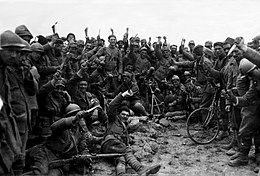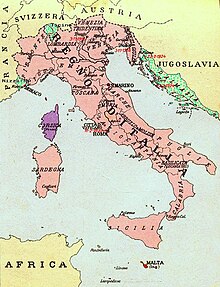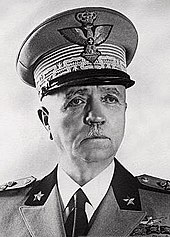Benito Mussolini
[13] Sorel's emphasis on the need for overthrowing decadent liberal democracy and capitalism by the use of violence, direct action, the general strike, and the use of neo-Machiavellian appeals to emotion, impressed Mussolini deeply.
[39] Prior to Mussolini taking a position on the war, a number of revolutionary syndicalists had announced their support of intervention, including Alceste De Ambris, Filippo Corridoni, and Angelo Oliviero Olivetti.
Thereafter he ... undertook a very active campaign in behalf of Italian intervention, participating in demonstrations in the piazzas and writing quite violent articles in Popolo d'Italia ...[27]In his summary, the Inspector also noted: He was the ideal editor of Avanti!
He was a sincere and passionate advocate, first of vigilant and armed neutrality, and later of war; and he did not believe that he was compromising with his personal and political honesty by making use of every means—no matter where they came from or wherever he might obtain them—to pay for his newspaper, his program and his line of action.
[38] The funds to create Il Popolo d'Italia—funneled through entrepreneur Filippo Naldi [it]—came from many sources, including domestic industrial and agrarian interests, such as the engineering giants Fiat and Ansaldo, and the governments of France and Britain.
[51] This perception of the failure of orthodox socialism in the light of the outbreak of World War I was not solely held by Mussolini; other pro-interventionist Italian socialists such as Filippo Corridoni and Sergio Panunzio had also denounced classical Marxism in favour of intervention.
[53] At this time, the Fascists did not have an integrated set of policies and the movement was small, ineffective in its attempts to hold mass meetings, and was regularly harassed by government authorities and orthodox socialists.
The promotion was recommended because of his exemplary conduct and fighting quality, his mental calmness and lack of concern for discomfort, his zeal and regularity in carrying out his assignments, where he was always first in every task involving labor and fortitude.
[75] The Fascisti, led by one of Mussolini's close confidants, Dino Grandi, formed armed squads of war veterans called blackshirts (or squadristi) with the goal of restoring order to the streets of Italy with a strong hand.
On the morning of 28 October, King Victor Emmanuel III, who according to the Albertine Statute held the supreme military power, refused the government request to declare martial law, which led to Facta's resignation.
[78] In a letter written before November 8 to Georgy Chicherin, Lenin judged that incident "a very convenient pretext" for the Soviets to "kick at Mussolini and have everyone (Vorovsky and the whole delegation) leave Italy, starting to attack her over her fascists", to "stage an international demonstration", and to "give the Italian people some serious help".
These included as the Blue Riband ocean liner SS Rex; setting aeronautical records with the world's fastest seaplane, the Macchi M.C.72; and the transatlantic flying boat cruise of Italo Balbo, which was greeted with much fanfare in the United States when it landed in Chicago in 1933.
Fascism opposed its version of idealism to prevalent rationalism, and used the Opera Nazionale Balilla to circumvent educational tradition by imposing the collective and hierarchy, as well as Mussolini's own personality cult.
His vision centered on forging a new Roman Empire in Africa and the Balkans, vindicating the so-called "mutilated victory" of 1918 imposed by Britain and France, which betrayed the Treaty of London and denied Italy its "natural right" to supremacy in the Mediterranean.
On 21 March 1939, during a meeting of the Fascist Grand Council, Italo Balbo accused Mussolini of "licking Hitler's boots" and criticized the pro-German policy as leading Italy to disaster.
[144] Mussolini's Under-Secretary for War Production, Carlo Favagrossa, had estimated that Italy could not be prepared for major military operations until 1942 due to its relatively weak industrial sector compared to western Europe.
[148] Mussolini planned to concentrate Italian forces on a major offensive against the British Empire in Africa and the Middle East, known as the "parallel war", while expecting the collapse of the UK in the European theatre.
Although Mussolini was aware that Italy, whose resources were reduced by the campaigns of the 1930s, was not ready for a long war, he opted to remain in the conflict to not abandon the occupied territories and the fascist imperial ambitions.
[171] Only two months after Mussolini had been dismissed and arrested, he was rescued from his prison at the Hotel Campo Imperatore in the Gran Sasso raid on 12 September 1943 by a special Fallschirmjäger (paratroopers) unit and Waffen-SS commandos led by Major Otto-Harald Mors; Otto Skorzeny was also present.
With the spread of the news of the arrest, several telegrams arrived at the command of the National Liberation Committee for Northern Italy from the Office of Strategic Services headquarters in Siena with the request that Mussolini be entrusted to Allied forces.
[181] In fact, clause number 29 of the armistice signed in Malta by Eisenhower and the Marshal of Italy Pietro Badoglio on 29 September 1943, expressly provided that: Benito Mussolini, his main Fascist associates and all persons suspected of having committed crimes of war or similar crimes, whose names are on the lists that will be delivered by the United Nations and which now or in the future are in territory controlled by the Allied Military Command or by the Italian Government, will be immediately arrested and handed over to the United Nations forces.
His real identity is unknown, but conventionally he is thought to have been Walter Audisio, who always claimed to have carried out the execution, though another partisan controversially alleged that Colonnello Valerio was Luigi Longo, subsequently a leading communist politician.
He denounced the Catholic Church for "its authoritarianism and refusal to allow freedom of thought ..." Mussolini's newspaper, La Lotta di Classe, reportedly had an anti-Christian editorial stance.
[199] The Church also regained authority over marriage, Catholicism could be taught in all secondary schools, birth control and freemasonry were banned, and the clergy received subsidies from the state and was exempted from taxation.
He would sometimes refer to himself as an "outright disbeliever", and once told his cabinet that "Islam was perhaps a more effective religion than Christianity" and that the "papacy was a malignant tumor in the body of Italy and must 'be rooted out once and for all', because there was no room in Rome for both the Pope and himself.
[222][223]In a speech given in Bari in 1934, he reiterated his attitude towards the German concept of a master race: Thirty centuries of history allow us to look with supreme pity on certain doctrines which are preached beyond the Alps by the descendants of those who were illiterate when Rome had Caesar, Virgil and Augustus.
[232] Proponents of this viewpoint argue that Mussolini's implementation of these laws reflected a homegrown Italian flavour of antisemitism distinct from that of Nazism,[233] one which perceived Jews as being bound to decadence and liberalism[234] and was influenced not just by Fascist ideology but also by the Catholic Church.
[237] Following the Second Italo-Senussi War, Mussolini directed Marshal Pietro Badoglio to ban miscegenation in Libya, fearing that Italian settlers in the colony would degenerate into "half-castes" if interracial relationships were permitted.
Though many of these laws were ignored by local officials due to the difficulty of properly enforcing them, Mussolini frequently complained to subordinates upon hearing of instances of them being broken and saw the need to micromanage race relations as part of his ideological vision.
Her stepsister Rachele Mussolini is also active in politics through Brothers of Italy, the main Italian right-wing party; she is the daughter of Romano and his second wife Carla Maria Puccini.


































